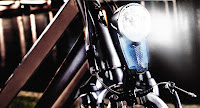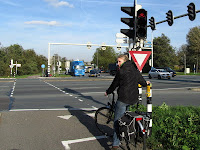Where cycling and music come together in any way, it is very likely you will be treated on Queen’s iconic Bicycle Race. Yes, there we go; that solo of numerous ringing bells halfway the song and of course curso paisagismo EAD those powerful lyrics:
“Bicycle, bicycle, bicycle, I want to ride my bicycle, I want to ride my bike, I want to ride my bicycle, I want to ride it where I like!”
It is a great song, always firing off a positive cycling vibe; haven’t we all been humming this song at some stage whilst being out with our bikes?


The first performer to be mentioned in this way is Boudewijn de Groot. Beyond the fact that non-native Dutch speakers shouldn’t even try to pronounce the name of this legendary Dutch singer, the man has written some extraordinary lyrics, at the heart of any Dutch person, whether they are actively into cycling or not.
To start, I’d like to treat you on the very famous first lines of his song Avond (Evening), the only Dutch language song annually featuring in the top ten of a Top2000 as voted by Dutch radio listeners. This song celebrates how two lovers finally are together, after seeing each other for many years. No, they don’t have to say goodbye to each other at the end of any evening any more; they live together! And how is this referred to?
“Nu hoef je nooit je jas meer aan te trekken en te hopen dat je licht het doet.”
"Now, you never have to put on your coat anymore, hoping your lights will work.”

Probably only to Dutch people, this is a crystal clear reference to cycling. You had a great night, but now it is time to face the fact; you have to cycle home in the dark and it is very likely that at least one of the lights on your bike (front or rear) won’t work, just because they never do. What will it be this time; a failing dynamo? Problems with the wiring or are the batteries flat? Brilliant poetry; cycling is not even mentioned, but every Dutch person just feels what is meant by these lyrics.

“Hoe sterk is de eenzame fietser die kromgebogen over zijn stuur tegen de wind zichzelf een weg baant?”
"How strong is that lonely cyclist, docked down on the handlebars, making his way against the headwinds?"

Yes, an iconic Dutch image, even better if you make this person a dad, taking his young child out for a ride (as shown on the original single cover). Whilst being out on the bike, dad’s mind is occupied with worries about the child’s future:
“Ik zit hier tevreden met de kleine op mijn schoot, de zon schijnt, er is geen reden, met rot weer en met harde wind te gaan fietsen met dat kind!”
“I sit here happily with the little one on my lap, the sun shines, there is no reason, with crap weather and strong winds, let’s go for a ride with that child!”

The image of a cyclist with a child on a seat fixed on the front handlebars (no, it is not dangerous!) is also subject of attention of Dutch comedian Herman Finkers who shelters behind his child when cycling in poor weather (see picture). Finkers:
“You know Dutch weather; head winds, rain, hail. Fortunately I have a child on the handlebars (audience laughing). We have two children, also one for my wife (more laughing).”
“You know Dutch weather; head winds, rain, hail. Fortunately I have a child on the handlebars (audience laughing). We have two children, also one for my wife (more laughing).”

There are numerous references in Dutch popular culture to children on bikes with their parents. Many Dutch people have warm memories of their childhood in relation to sitting on the back of their parent’s bike (note in this way, the child can shelter behind the parent!). With the years passing by, many forget how uncomfortable this actually was. In Paul van Vliet’s song Veilig Achterop (safely on the back) feelings of nostalgia take an all-time high:

“Veilig achter bij vader op de fiets, vader weet de weg en ik weet nog van niets. Veilig achterop, ik ben niet niet alleen, vader weet waarheen. Ik weet nog hoe het rook, ik weet nog hoe het was; m’n armen om ‘m heen, m’n wang tegen z’n jas.”
“Safely on the back with daddy on the bike, daddy knows the way and I don’t have a clue. Safely on the back, I am not alone, yes, daddy knows where to go. I remember the smells, I know how it was; my arms around him, my cheek against his coat.”
Wow! As a truly Dutch person I can’t help getting tearful myself whilst translating these words into English.

We have to stick a little bit longer to the image of someone taking a lift on the luggage rack of someone else’s bike. As you’ll understand, many Dutch marriages originate from that one afternoon/evening when the boy took the girl for a ride. I even know a Dutch lady living in the UK who is now married to a British man, after taking him on the back of her bike after the last bus was gone (believe it or not, this happened in Birmingham!). Their wedding pictures featured the original bike of the outing, echoing Eddie Christiani's Spring maar achterop (just jump on the back) from the 1950s, exactly covering this topic:
“Mijn achterband is wel wat zacht, maar ‘t geeft niet lieve pop, spring maar achterop, spring maar achterop”.
“My rear tyre is a bit flat, but it doesn’t matter dear, just jump on the back, just jump on the back!”
 The latest addition to this theme is a rap-song by Gers Pardoel, with his "Bagagedrager" ("luggage rack"-song). His animated "spring maar achterop bij mij" - just jump on the back with me - was a big hit in 2011 in both The Netherlands and Dutch-speaking Belgium; a potential hit when sung in English?
The latest addition to this theme is a rap-song by Gers Pardoel, with his "Bagagedrager" ("luggage rack"-song). His animated "spring maar achterop bij mij" - just jump on the back with me - was a big hit in 2011 in both The Netherlands and Dutch-speaking Belgium; a potential hit when sung in English?
"Just jump on the back with me, than we go together, I don't know where, but who cares, I know the way"...

"Just jump on the back with me, than we go together, I don't know where, but who cares, I know the way"...

You could say that this brings us into a full circle with Queen’s “fat bottomed girls”, although Freddy Mercury never envisioned one of these girls to jump on the back of her lover’s bike. Mercury got his inspiration for “Bicycle Race” from the Tour de France, so the last topic to be covered in this article is to what extend the “biggest cycle race of the world” also inspired Dutch musicians.
In this respect, composer Rein van den Broek (playing in picture on right) needs mentioning. In the 1970s he composed two iconic tunes for NOS Radio Tour de France, an annual 3-week highlight on Dutch radio with live coverage from the race, back ground stories by Dutch tour buffs and a great mix of feel-good summer music. When Dutch people hear Van den Broek’s legendary Trumpet Cross opening tune at five past two on the first Saturday of July, they truly know summer has arrived!

Another classic element of this radio programme is “the last 5 km”. At the moment when the first rider passes under the flag of the last 5 km, Van den Broek’s famous Tarantuella Tune kicks in, whilst reporters keep updating listeners live from the race. Reporters deliberately take breaths from their rushed talking for ten seconds or so, whilst the studio’s technician boosts the volume of the tune during these breaks. This mix of talking and music continues for five thrilling minutes or so, until the moment the first rider passes the finish line. At that moment, the music gets rigidly faded out. It is a great Dutch tradition, only to be enjoyed for three weeks per year and valued by many listeners. It might be this tune what is on par with Queen’s Bicycle Race for Dutch people. When I find myself in the last 5 km of a lengthy ride myself, I can’t help humming this tune. I am sure I am not the only one…
 Cycling in Amsterdam and The Netherlands - The very best routes in the cyclist's paradise makes you travel beyond Dutch cliches like clogs, windmills and the Amsterdam red light district, allowing you to truly explore the lowlands. The book features 1064 kms of routes and has special chapters explaining the unique Dutch cycling-minded traffic rules and its cycle route signage systems; 164 pages, colour, wiro bound, fits in standard handlebar bag, see also http://www.cyclinginholland.com.
Cycling in Amsterdam and The Netherlands - The very best routes in the cyclist's paradise makes you travel beyond Dutch cliches like clogs, windmills and the Amsterdam red light district, allowing you to truly explore the lowlands. The book features 1064 kms of routes and has special chapters explaining the unique Dutch cycling-minded traffic rules and its cycle route signage systems; 164 pages, colour, wiro bound, fits in standard handlebar bag, see also http://www.cyclinginholland.com.

What about getting on your bicycle yourself with one of my "Cycling Dutchman" guidebooks?


The London - Land's End Cycle Route Book is designed for those who LOVE cycling, but don't like traffic. The book takes you onto the most beautiful cycle routes of southern England, including the Camel Trail, Devon Coast to Coast Route, Bristol and Bath Railway path, Thames Valley route and many more! What makes the book unique is that the route is completely continuous, including detailed directions and local knowledge all the way. Get inspired; choose your favourite route sections or go for a full summer holiday adventure; 164 pages, colour, wiro bound, fits in standard handlebar bag, £ 15.99, see also http://www.london-landsendcycleroutebook.com.

Cycle paths and cycle lanes; the full story!
Sharing the road or segregated cycle paths? Well it is both!

 Dutch style bike rides in the United Kingdom:
Dutch style bike rides in the United Kingdom:
London by bicycle: The East-West Cycle Route
From Bristol into the Somerset Levels
Devon Coast to Coast
An international cycling holiday with toddlers
Other popular Cycling Dutchman blog articles:
Explaining Dutch cycling infrastructure:
Cycle paths and cycle lanes; the full story!
Sharing the road or segregated cycle paths? Well it is both!

London by bicycle: The East-West Cycle Route
From Bristol into the Somerset Levels
Devon Coast to Coast
An international cycling holiday with toddlers